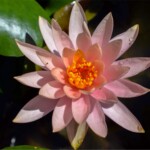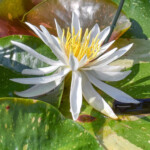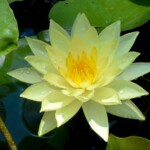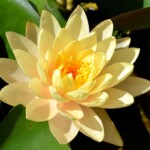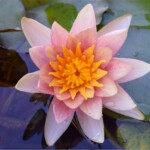Your pond needs plants. But most plants need sunlight.
So what do you do if your pond sits under the shade of a tree or your house?
Luckily, you still have lots of options.
Before we dive into our list of tried-and-true shade-tolerant plants, let’s talk a little about why having these plants is so important. Plants pull excess nutrients – specifically nitrates – out of your pond. If left to flourish, these nitrates feed string algae. Each color, type and size of plant you add eats a different kind of nitrate, so, the more – and the wider variety – of plants you have, the less likely string algae will run rampant in your pond.
All of the plants listed below will not only add some greenery to the shaded area of your pond but also help keep your ecosystem balanced. They’ll work great in sunny areas too, so make sure to pick up plenty to plant throughout your entire pond!
1. Horsetail
Scientific Name:Â Equisetum hyemale
Flower: Not Significant
Hardiness: To Zone 4 (Winter Hardy in PA/MD)
Height: 3 Feet
Where to Plant: Moist Soil or Shallow Water (Up to 2 Inches Deep)
PA/MD Native: Yes
Much sought after for its unique evergreen foliage, horsetail has bamboo-like stalks with a distinct cylindrical form. Horsetail is also available in a miniature form (Equisetum scirpioides) that only grows to about 6 inches high, as well as a giant form (Equisetum hyemale ‘Robustum’) that can reach heights up to 6 feet.
2. Marsh Marigold
Scientific Name:Â Caltha palustris
Flower: Yellow
Bloom Time: Spring
Hardiness: To Zone 3 (Winter Hardy in PA/MD)
Height: 3 Feet
Where to Plant: Moist Soil or Shallow Water (Up to 2 Inches Deep)
PA/MD Native: Yes
Waxy and bright, Marsh Marigolds are some of the first pond plants to bloom in early spring. Sunny golden yellow flowers shine above mounds of round green foliage.
3. Dwarf Golden Sweet Flag
Scientific Name:Â Acorus gramineus ‘Oborozuki’
Flower: Not Significant
Hardiness: To Zone 3 (Winter Hardy in PA/MD)
Height: 8-12 Inches
Where to Plant: Moist Soil or Shallow Water (Up to 2 Inches Deep)
PA/MD Native: No
This well-mannered grass-like plant is compact and particularly well suited to streams. Dwarf Golden Sweet Flag’s green-yellow blades are semi-evergreen.
4. Blue Flag Iris
Scientific Name:Â Iris versicolor
Flower: Blue
Bloom Time: Spring
Hardiness: To Zone 4 (Winter Hardy in PA/MD)
Height: 2-3 Feet
Where to Plant: Moist Soil or Shallow Water (Up to 6 Inches Deep)
PA/MD Native: Yes
Blue Flag Iris is a staple in many water gardens. This reliable bloomer grows well in full sun or moderate shade and is more mild-mannered and clump-habited than most Iris. The purplish blue flowers have a touch of yellow on the inside of each petal.
5. Cardinal Flower
Scientific Name:Â Lobelia cardinalis
Flower: Red
Bloom Time: Summer
Hardiness: To Zone 4 (Winter Hardy in PA/MD)
Height: 2 Feet
Where to Plant: Moist Soil or Shallow Water (Up to 2 Inches Deep)
PA/MD Native: Yes
Cardinal Flower’s red blooms stand on tall spikes and stay open for weeks, attracting hummingbirds and butterflies. This eye-catcher is also available in a pink variety (Lobelia x speciosa ‘Pink’) and is closely related to the burgundy-stemmed Queen Victoria (Lobelia fulgens ‘Queen Victoria’).
6. Water Forget-Me-Not
Scientific Name:Â Myosotis scorpioides
Flower: Blue
Bloom Time: Spring/Summer
Hardiness: To Zone 3 (Winter Hardy in PA/MD)
Height: 6 Inches
Where to Plant: Moist Soil or Shallow Water (Up to 2 Inches Deep)
PA/MD Native: No
Water Forget-Me-Nots are a favorite of ours for tucking into streams and waterfalls. This lush plant creates a beautiful carpet of green foliage speckled by blue flowers that bloom in spring and keep going strong into summer.
7. Bog Bean
Scientific Name:Â Menyanthes trifoliata
Flower: White
Bloom Time: Spring
Hardiness: To Zone 3 (Winter Hardy in PA/MD)
Height: 6-8 Inches
Where to Plant: Shallow Water (1-6 Inches Deep)
PA/MD Native: Yes
Bog Bean’s buoyant stems reach out from the shoreline and float out over the water. Fuzzy trumpet-shaped white flowers appear in spring. Bog Bean also creates a haven for frogs, who like to hide and hop among the leaves.
8. Water Hawthorne
Scientific Name:Â Aponogeton distachyos
Flower: White
Bloom Time: Spring, Fall
Hardiness: To Zone 4 (Winter Hardy in PA/MD)
Spread: 1-2 Feet
Where to Plant: Deep Water (10-24 Inches Deep)
PA/MD Native: Yes
Water Hawthorne is a great alternative to waterlilies in shade-covered ponds. Although the dainty white flowers are much smaller than those of a waterlily, the oval-shaped green leaves float beautifully over the pond, creating shade for fish. Water Hawthorne blooms heaviest when water temperatures are above freezing but below 55 degrees.
9. Lizard’s Tail
Scientific Name:Â Saururus cernuus
Flower: White
Bloom Time: Summer
Hardiness: To Zone 4 (Winter Hardy in PA/MD)
Height: 1-2 Feet
Where to Plant: Moist Soil or Shallow Water (Up to 2 Inches Deep)
PA/MD Native: Yes
Lizard’s Tail earns its name from the spikes of tiny white flowers that curve down from the top of the plant’s long stems. These flowers become green fruit that looks like the scales of a little dragon.
10. Golden Club
Scientific Name:Â Orontium aquaticum
Flower: Yellow
Bloom Time: Summer
Hardiness: To Zone 6 (Winter Hardy in PA/MD)
Height: 1-2 Feet
Where to Plant: Moist Soil or Shallow Water (Up to 6 Inches Deep)
PA/MD Native: Yes
Golden Club is a unique-looking plant that sprouts white clubs covered in tiny yellow flowers at their tips. Thick green leaves that can go grow up to a foot long serve as the perfect backdrop for these unusual blooms. Golden Club is slow to establish itself, but, once it does, it’s virtually maintenance-free.
11. Arrow Arum
Scientific Name:Â Peltandra virginica
Flower: Not Significant
Hardiness: To Zone 5 (Winter Hardy in PA/MD)
Height: 2-3 Feet
Where to Plant: Moist Soil or Shallow Water (Up to 10 Inches Deep)
PA/MD Native: Yes
What Arrow Arum lacks in flowers it provides in stature. This leafy plant has impressive waxy green foliage that can grow up to 2 feet long and sprouts a spadix (a club of tiny flowers) instead of regular flowers.
12. Taro
Scientific Name:Â Colocasia esculenta
Flower: Not Significant
Hardiness: To Zone 8 (Tropical)
Height: 3-5 Feet
Where to Plant: Moist Soil or Shallow Water (Up to 6 Inches Deep)
PA/MD Native: No
Taro plants come in a variety of colors and sizes but are all characterized by large, showy leaves – earning them the nickname “Elephant Ear.” Some popular varieties include Tea Cup Taro (pictured), bright green Elena Taro and purple-tinged Violet-Stemmed Taro.
13. Umbrella Palm
Scientific Name:Â Cyperus alternifolius
Flower: Not Significant
Hardiness: To Zone 8 (Tropical)
Height: 4-5 Feet
Where to Plant: Moist Soil or Shallow Water (Up to 6 Inches Deep)
PA/MD Native: No
Umbrella Palm boasts a tropical-looking star of green leaves atop a bare stem. It’s also available in a dwarf variety (Cyperus alternifolius ‘Gracilis’) that has finer leaves and only grows 2 to 3 feet high.
14. Compact Papyrus
Scientific Name:Â Cyperus percamentus
Flower: Not Significant
Hardiness: To Zone 8 (Tropical)
Height: 2-3 Feet
Where to Plant: Moist Soil or Shallow Water (Up to 10 Inches Deep)
PA/MD Native: No
Similar to Umbrella Palm, Compact Papyrus’s leaves stand atop a naked green stem. This foliage is finer and more abundant than that of Umbrella Palm, however, making the plant look almost like a feather duster.
15. Water Hyacinth
Scientific Name:Â Eichhornia crassipes
Flower: Purple
Bloom Time: Summer
Hardiness: To Zone 8 (Tropical)
Height: 6-12 Inches
Where to Plant: Floating
PA/MD Native: No
This popular floating plant has thick clumps of roots that pull tons of nutrients out of the water, making it a great tool for fighting string algae. Purple flowers bloom throughout the warmer months. Water hyacinths can quickly overwhelm a pond, so thin them out as they spread (composted hyacinths make great fertilizer for roses!).
16. Water Lettuce
Scientific Name:Â Pistia stratiotes
Flower: Not Significant
Hardiness: To Zone 9 (Tropical)
Spread: 6-12 Inches
Where to Plant: Floating
PA/MD Native: No
Water Lettuce’s big green leaves float in the pond, taking out lots of nutrients that would otherwise feed string algae. Like Water Hyacinths, Water Lettuce has the potential to overwhelm the pond if not controlled, especially in warmer climates.
What about Waterlilies?
You might notice we don’t have any waterlilies on our list of shade-tolerant pond plants. That’s because most lilies perform best in full sunlight. The less sun on your lily, the less likely you are to get big, beautiful blooms.
A few varieties of hardy waterlily, however, do perform OK with just three or four hours of sunlight each day. They include the pink Comanche and Colorado, white Arc-en-ciel, peach Clyde Ikins and yellow Texas Dawn and Joey Tomocik.
Related Links
How to Plant a Floating Island for Your Pond
